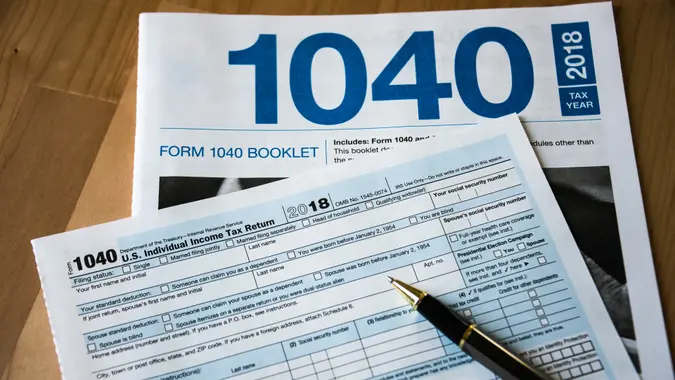Claiming Dependents on Taxes: What Parents and Guardians Need To Know

Commitment to Our Readers
GOBankingRates' editorial team is committed to bringing you unbiased reviews and information. We use data-driven methodologies to evaluate financial products and services - our reviews and ratings are not influenced by advertisers. You can read more about our editorial guidelines and our products and services review methodology.

20 Years
Helping You Live Richer

Reviewed
by Experts

Trusted by
Millions of Readers
Want to unlock tax savings? Claiming a dependent on your tax return can reduce what you owe or boost your refund. But if you’re divorced, share custody or unsure about eligibility, the IRS rules can be confusing. This guide breaks it all down in plain English.
What Is a Dependent for Tax Purposes?
A dependent is someone you support financially and can claim on your taxes. Most often, that’s a child or a relative who lives with you.
There are two types:
Qualifying Child
To qualify, the person claiming the dependent must meet these requirements:
- Relationship: Must be your child, stepchild, sibling, grandchild, niece/nephew or foster child.
- Age: Must be under 19 or 24 if the child is a full-time student. The age limit doesn’t apply if the child is permanently disabled.
- Residence: The qualifying child must live with you for more than half the year.
- Support: The child didn’t provide more than half of their support.
- Filing Status: The child didn’t file a tax return.
Qualifying Dependent
To claim a qualifying dependent, you must meet all of these requirements:
- Not a qualifying child of someone else. The dependent can’t be the qualifying child of anyone else.
- Residence or relationship. The dependent must live with you all year or have a relationship with you as either parent, grandparent, cousin, in-law or friend.
- Gross income limit. The qualifying dependent’s gross income has to be less than $5,050. This limit is subject to change.
- Support. You provide over half of their support.
Who Can Claim a Child as a Dependent?
You don’t have to be the child’s parent to claim them, but you do have to meet the IRS rules.
People who can qualify:
- Biological, adoptive or step-parents
- Grandparents or legal guardians
- Siblings, aunts, uncles, or other relatives
- Non-relatives (if the child lived with them all year)
But here’s the catch: Only one person can claim the child each tax year.
IRS Rules for Split Custody or Child Support
In shared custody or divorce situations, the parent the child lives with more than 50% of the year usually gets the tax claim.
Tiebreaker Rule
If both parents try to claim the same child, the IRS uses these rules:
- The parent the child lived with the longest wins.
- If time is equal, the parent with the higher AGI wins.
- If neither person is a parent, the highest AGI claimant wins.
Head of Household: Custodial Parent Only
Only the custodial parent (where the child lives most of the year) can file as head of household, which comes with:
- A higher standard deduction
- Lower tax rates
Child Support Doesn’t Equal Tax Rights
Paying child support doesn’t automatically give you the right to claim the child. The IRS bases it on where the child lives, not who pays. IRS clarifies that noncustodial parents can’t claim dependents without Form 8332, even if they pay support.
How Form 8332 Works for Noncustodial Parents
If the custodial parent agrees to let the noncustodial parent claim the child, they must fill out and sign IRS Form 8332.
What It Does
- Let the noncustodial parent claim the Child Tax Credit (CTC) and Credit for Other Dependents
- Overrides the default rule favoring the custodial parent
What the Noncustodial Parent Must Do
- Attach Form 8332 to their tax return
- Keep a signed copy and any written agreement
Can It Be Revoked?
Yes. The custodial parent can revoke Form 8332 by:
- Writing to the IRS
- Notifying the other parent by December 31 of the year before the change
Form 8332 Summary Table
| Parent Type | Can Claim Child? | Need Form 8332? | Eligible for CTC? |
|---|---|---|---|
| Custodial Parent | Yes | No | Yes |
| Noncustodial (with Form 8332) | Yes | Yes | Yes |
| Noncustodial (without Form) | No | — | No |
Tax Benefits for Parents Claiming Dependents
Parents eligible to claim their child as a dependent may qualify for several tax benefits, which can significantly reduce their tax liabilities. Here are some key benefits to consider:
- Child Tax Credit (CTC). The Child Tax Credit is one of the most valuable tax credits available for parents. Starting in tax year 2023, eligible parents can receive up to $2,000 per qualifying child under the age of 17. The credit is partially refundable, meaning you may still get a refund even if you owe no taxes.
- Earned Income Tax Credit (EITC). Parents with low to moderate incomes may qualify for the Earned Income Tax Credit. The amount of the credit depends on income, filing status and the number of qualifying children and it can result in a substantial refund. IRS data shows the average EITC refund was $2,541 in 2023, but it could result in a refund of over $6,900 for some families.
- Child and Dependent Care Credit. If you pay for child care so that you can work or look for work, you may qualify for the Child and Dependent Care Credit. This credit covers a percentage of your qualifying child care expenses, with a maximum allowable expense of $3,000 for one child or $6,000 for two or more children.
- Head of Household Filing Status. If you are an unmarried parent and can claim your child as a dependent, you may qualify to file as Head of Household. This filing status typically offers a higher standard deduction and lower tax rates compared to filing as Single.
- Education Tax Credits. If your dependent child is in college, you may be eligible for education credits like the American Opportunity Tax Credit (AOTC) or the Lifetime Learning Credit. These credits can help offset the cost of tuition, fees and other qualifying expenses.
What If You Can’t Claim Your Child as a Dependent?
You do lose out on benefits when you can’t claim your child as a dependent, but there may be other options you can qualify for.
- Child and Dependent Care Tax Credit. You may qualify if you’re the custodial parent paying for child care, even if the noncustodial parent claims the child as a dependent. Check IRS Publication 503 for divorced or separated parent rules.
- Premium Tax Credit. If your child is covered by a Marketplace health plan, the amount of credit you’ll get depends on your estimated income and the household information reported on your Marketplace application.
- Education Tax Credits. If you pay for your child’s education expenses, like tuition, books or other qualified costs, you may qualify for certain education tax benefits, even without claiming the child as a dependent. For example, the American Opportunity Tax Credit (AOTC) and the Lifetime Learning Credit are available if you meet the income requirements and your child meets the eligibility criteria for a qualifying student. According to the U.S. Department of Education, education credits can reduce your tax bill dollar-for-dollar for most families, translating to serious savings come tax time.
What If You Can’t Claim Your Child?
You won’t get all the tax perks, but you may still qualify for:
- Child Care Credit if you’re the custodial parent who paid for care
- Premium Tax Credit if your child’s on a Marketplace health plan
- Education Tax Credits, if you paid tuition, even if you don’t claim the child
Final Take: What to Remember About Claiming Dependents
- Only one parent can claim a child as a dependent in a given year
- The custodial parent usually has priority, but they can release the claim using IRS Form 8332
- Claiming a dependent may unlock valuable tax benefits like the Child Tax Credit or Head of Household status
- Be sure to follow IRS rules to avoid rejection or audit triggers
- When in doubt, consult a tax advisor to determine eligibility and avoid filing errors
FAQ
Here are the answers to some of the most frequently asked questions about claiming dependents on taxes and how exactly it works:- Can both parents claim the child tax credit?
- No. Only one parent can claim the child per year.
- What happens if both parents file for the same child?
- The IRS uses tie-breaker rules. If neither backs down, both returns may be delayed or audited.
- Can I claim a child who doesn’t live with me?
- Only if the custodial parent gives you Form 8332.
- Can grandparents or legal guardians claim dependents?
- Yes, if the child lived with them for over 6 months and they provided over half of the support.
Data is accurate as of July 3 and is subject to change.
Editorial Note: This content is not provided by any entity covered in this article. Any opinions, analyses, reviews, ratings or recommendations expressed in this article are those of the author alone and have not been reviewed, approved or otherwise endorsed by any entity named in this article.
Our in-house research team and on-site financial experts work together to create content that’s accurate, impartial, and up to date. We fact-check every single statistic, quote and fact using trusted primary resources to make sure the information we provide is correct. You can learn more about GOBankingRates’ processes and standards in our editorial policy.
- IRS "Tax Information for Non-Custodial Parents"
- IRS "Child and Dependent Care Expenses"
- IRS "FAQ"
- IRS "Dependents"
- IRS "Education credits - AOTC and LLC"
- IRS "Statistics for tax returns with the Earned Income Tax Credit (EITC)"
- IRS "About Form 8332, Release/Revocation of Release of Claim to Exemption for Child by Custodial Parent"
- IRS "Topic no. 602, Child and Dependent Care Credit"
- IRS "Divorced and separated parents"
 Written by
Written by  Edited by
Edited by 

























